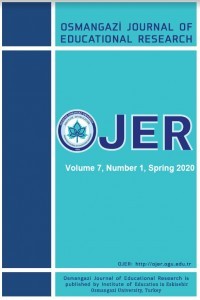From Congruent Angles to Congruent Trıangles: The Role of Dragging, Grid and Angle Tools of A Dynamic Geometry System
From Congruent Angles to Congruent Trıangles: The Role of Dragging, Grid and Angle Tools of A Dynamic Geometry System
___
- Baccaglini-Frank, A., and Mariotti, M. A. (2010). Generating conjectures in dynamic geometry: The maintaining dragging model. International Journal of Computers for Mathematical Learning, 15(3), 225–253. https://doi.org/10.1007/s10758-010- 9169-3
- Bartolini Bussi, M. G., and Mariotti, M. A. (2008). Semiotic mediation in the mathematics classroom: Artifacts and signs after a Vygotskian perspective. In L. English, M. Bartolini Bussi, G. Jones, R. Lesh, & D. Tirosh (Eds.), Handbook of International Research in Mathematics Education (2., pp. 746–783). Mahwah, NJ: Erlbaum.
- Baykul, Y. (2014). Ortaokulda Matematik Öğretimi (5-8. Sınıflar) (2nd ed.). Ankara: Pegem Akademi.
- Drijvers, P. (2003). Learning algebra in a computer algebra environment. Design research on the understanding of the concept of parameter. Utrecht: CD-Béta Press.
- Freudenthal, H. (1983). Didactic phenomenology of mathematical structures. Dordrecht: Reidel Publishing Company.
- Leung, A. (2008). Dragging in a dynamic geometry environment through the lens of variation. International Journal of Computers for Mathematical Learning, 13(2), 135–157. https://doi.org/10.1007/s10758-008-9130-x
- Leung, A. (2011). An epistemic model of task design in dynamic geometry environment. https://doi.org/10.1007/s11858-011-0329-2
- Leung, A., Baccaglini-Frank, A., and Mariotti, M. A. (2013). Discernment of invariants in dynamic geometry environments. Educational Studies in Mathematics, 84(3), 439–460.
- Lopez-Real, F., and Leung, A. (2006). Dragging as a conceptual tool in dynamic geometry environments. International Journal of Mathematical Education in Science and Technology, 37(6), 665–679. https://doi.org/10.1080/00207390600712539
- Maher, C. A., and Sigley, R. (2014). Task-Based Interviews in Mathematics Education. In S. Lerman (Ed.), Encyclopedia of Mathematics Education (pp. 579–582). Dordrecht: Springer Netherlands. https://doi.org/10.1007/978-94-007-4978-8_147
- Mariotti, M. A. (2013). Introducing students to geometric theorems : how the teacher can exploit the semiotic potential of a DGS. ZDM Mathematics Education, 45(3), 441–452. https://doi.org/10.1007/s11858-013-0495-5
- Mariotti, M. A. (2014). Transforming images in a DGS: The semiotic potential of the dragging tool for introducing the notion of conditional statement. In S. Rezat, M. Hattermann, & A. Peter-Koop (Eds.), Transformation - A Fundamental Idea of Mathematics Education (pp. 155–172). New York: Springer. https://doi.org/10.1007/978-1-4614-3489-4_8
- MEB. (2013). Ortaokul Matematik Dersi Öğretim Programı [Mathematics Curricula for 5., 6., 7. and 8 Grades]. Ankara: Talim Terbiye Kurulu Başkanlığı.
- Narlı, S. (2016). İlişkilendirme Becerisi ve Muhtevası. In E. Bingölbali, S. Arslan, & İ. Ö. Zembat (Eds.), Matematik Eğitiminde Teoriler (pp. 231–244). Ankara: Pegem Akademi.
- Tall, D., & Vinner, S. (1981). Concept image and concept definition in mathematics with particular reference to limits and continuity. Educational Studies in Mathematics, 12(2), 151–169.
- Trouche, L. (2004). Managing the complexity of human/machine interactions in computerized learning environments: Guiding students’ command process through instrumental orchestrations. International Journal of Computers for Mathematical Learning, 9(3), 281–307.
- Van de Walle, J. A., Karp, K. S., and Bay-Williams, J. M. (2010). Elementary and Middle School Mathematics: Teaching Developmentally (3rd ed.). NY, US: Pearson Education, Inc.
- Yılmaz, S., ve Nasibov, F. H. (2012). 7. Sınıf öğrencilerinin aynı düzlemdeki üç doğrunun oluşturduğu açılar ile ilgili hata ve kavram yanılgısı türleri. X. Ulusal Fen Bilimleri ve Matematik Eğitimi Kongresi. Niğde Üniversitesi, Niğde, Türkiye. Retrieved from http://kongre.nigde.edu.tr/xufbmek/dosyalar/tam_metin/pdf/2300- 29_05_2012-00_11_52.pdf
- Yayın Aralığı: Yılda 2 Sayı
- Başlangıç: 2018
- Yayıncı: Eskişehir Osmangazi Üniversitesi
Mustafa Zafer BALBAĞ, Ersin KARADEMİR
Recycling as a Value In Primary and Secondary Curriculums
Engin YILMAZ, Macid Ayhan MELEKOĞLU
İlkokul ve Ortaokul Öğretim Programlarında Bir Değer Olarak Geri Dönüşüm
Lecturers’ Opinions about the Effect of Law No: 6528 on Educational Administration Field
Engin YILMAZ, Macid Ayhan MELEKOĞLU
6528 Sayılı Yasanın Eğitim Yönetimi Alanına Yansımasına İlişkin Öğretim Üyelerinin Görüşleri
